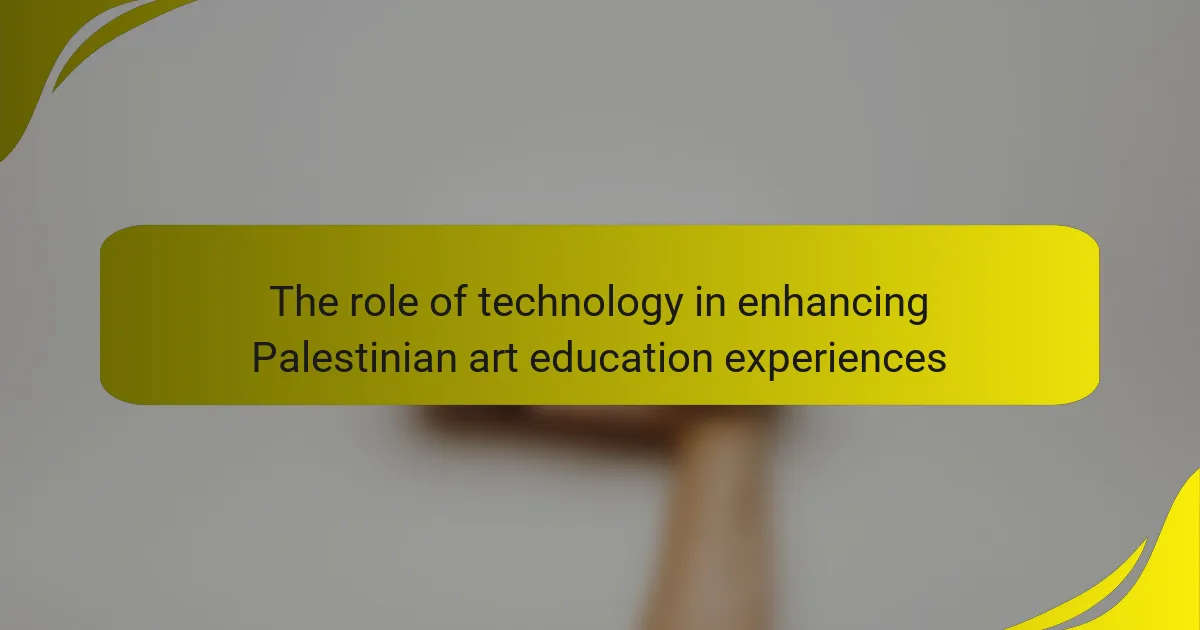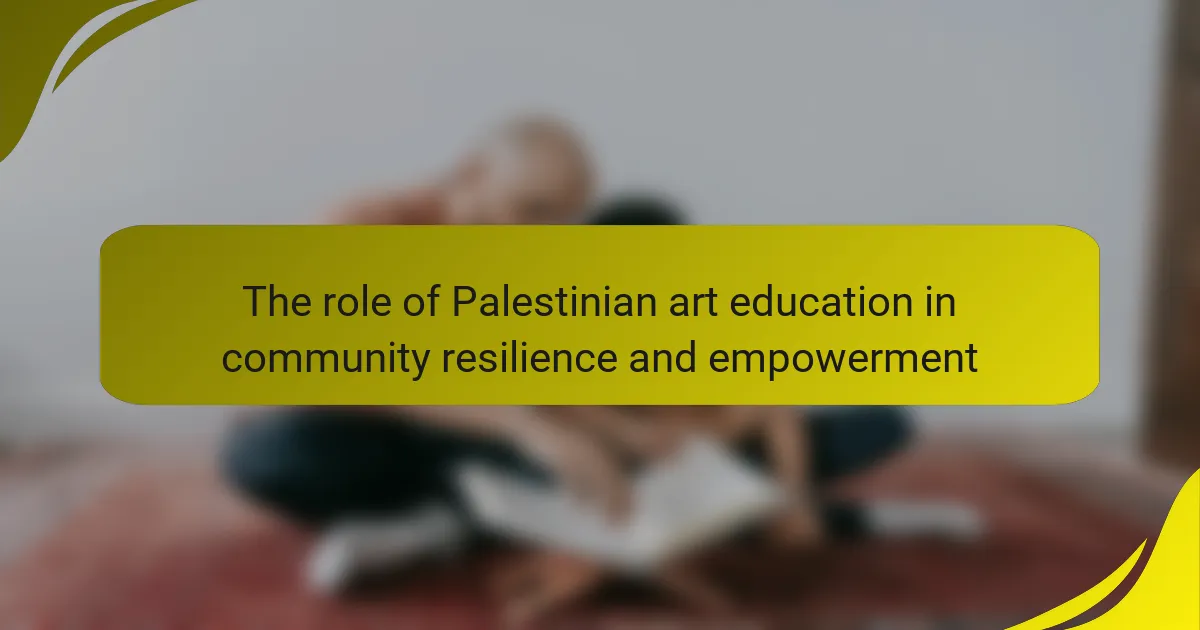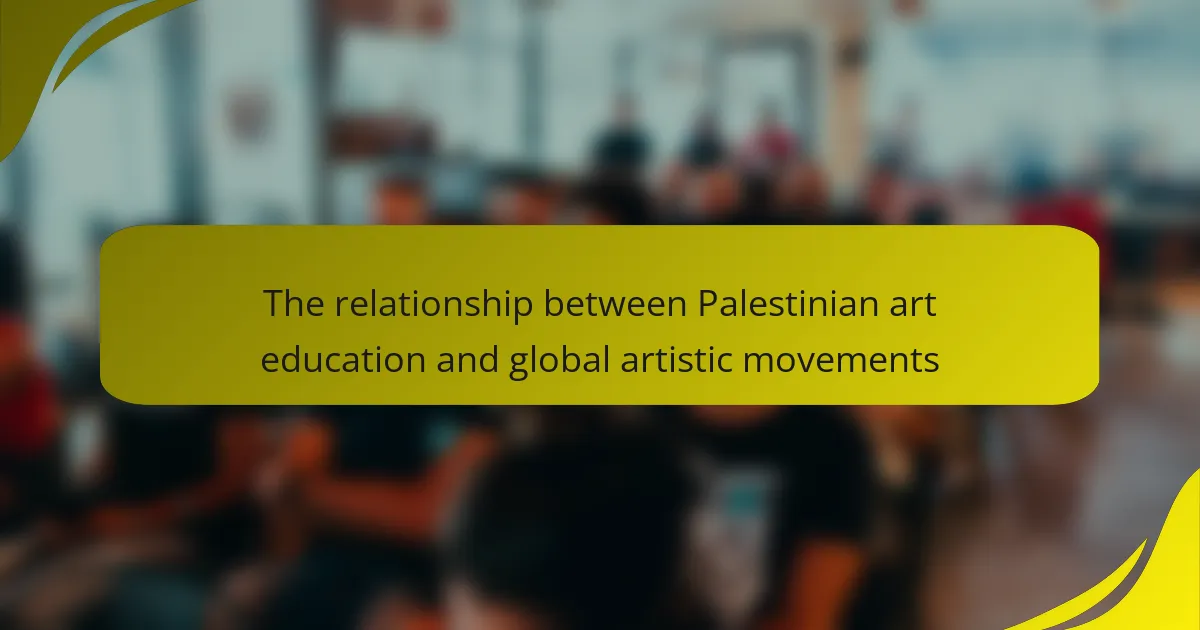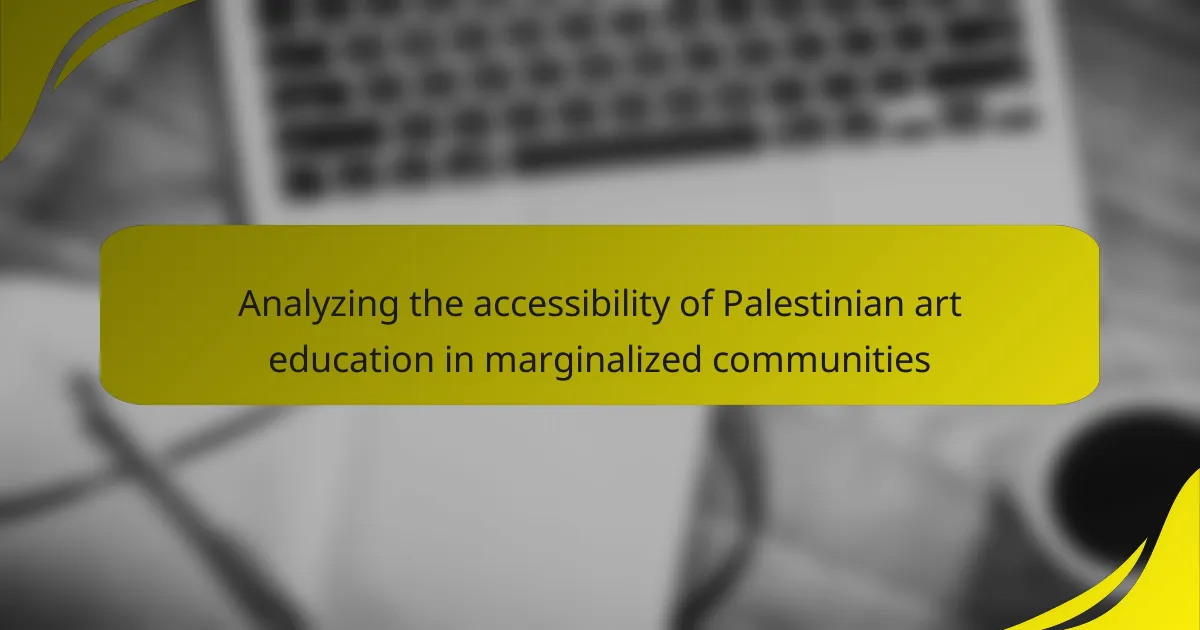Palestinian art education practices have been shaped by a complex interplay of historical events and socio-political factors. The introduction of formal art education during the Ottoman Empire, followed by the British Mandate’s promotion of Western styles, laid the foundation for contemporary practices. The 1948 Nakba disrupted traditional education, leading to a focus on identity and resistance in art, while the establishment of the Palestinian Authority in the 1990s allowed for curricula that emphasized local heritage. Current challenges, including political instability, limited resources, and restrictions on movement, continue to affect access to art education and influence the themes explored by Palestinian artists. This article examines these historical influences and contemporary challenges, providing insights into the evolving landscape of art education in Palestine.
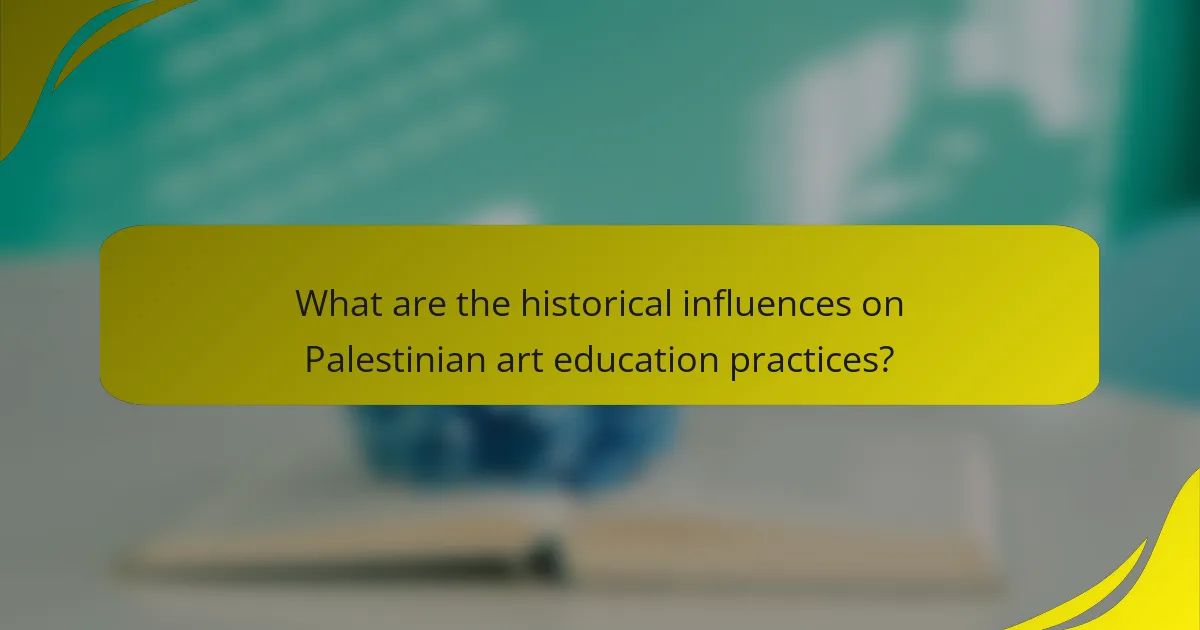
What are the historical influences on Palestinian art education practices?
Palestinian art education practices have been significantly influenced by historical events and cultural exchanges. The Ottoman Empire’s rule introduced formal education systems, including art, in the 19th century. The British Mandate further shaped these practices by establishing institutions that promoted Western artistic styles. The 1948 Nakba led to a disruption in traditional art education, resulting in a focus on identity and resistance in art. The establishment of the Palestinian Authority in the 1990s allowed for the development of local curricula that emphasized Palestinian heritage. The ongoing conflict has also influenced art education, fostering a sense of resilience and activism among artists. These historical influences have created a unique blend of traditional and contemporary practices in Palestinian art education.
How have cultural factors shaped Palestinian art education?
Cultural factors have significantly shaped Palestinian art education by influencing its themes, methods, and accessibility. The historical context of the Palestinian struggle for identity has led to art education focusing on cultural heritage and resistance. Traditional Palestinian crafts and folklore are integrated into curricula, fostering a sense of belonging and continuity. Furthermore, socio-political conditions have impacted resources available for art education, often leading to limited access in marginalized communities. The role of community organizations in promoting art education has become crucial, as they provide platforms for expression amidst adversity. This emphasis on cultural identity and resilience has made art a vital tool for social commentary and activism in Palestinian society.
What specific cultural traditions influence art education in Palestine?
Cultural traditions influencing art education in Palestine include Islamic art, folkloric practices, and historical storytelling. Islamic art emphasizes geometric patterns and calligraphy, which are often integrated into educational curricula. Folkloric practices, such as embroidery and traditional crafts, also play a significant role in shaping artistic expression. Historical storytelling is a vital component, as it preserves cultural narratives and influences creative themes in art. Additionally, the Palestinian identity and resistance are expressed through art, impacting educational approaches. These traditions collectively enrich the art education landscape in Palestine.
How do historical events impact the curriculum of art education in Palestine?
Historical events significantly shape the curriculum of art education in Palestine. The ongoing conflict and occupation influence the themes and content taught in art programs. Historical narratives are often reflected in artistic expressions, emphasizing resilience and identity. For example, the Nakba, or the Palestinian exodus of 1948, is a central theme in many art curricula. This historical event informs students’ understanding of their cultural heritage and struggles. Art education in Palestine often incorporates local history, fostering a connection between students and their past. Furthermore, international influences and collaborations can also alter the curriculum, introducing global perspectives on art. These historical contexts create a unique educational framework that addresses both local and universal themes in art.
What role does colonial history play in shaping art education in Palestine?
Colonial history significantly influences art education in Palestine. The legacy of colonialism has shaped the curriculum and access to resources. Art education often reflects resistance against colonial narratives. It emphasizes indigenous culture and identity. Palestinian artists use art as a form of political expression. The educational system is impacted by restrictions on freedom and movement. Historical events, such as the Nakba, influence artistic themes. These elements create a unique context for art education in Palestine.
How has colonialism affected artistic expression in Palestinian education?
Colonialism has significantly restricted artistic expression in Palestinian education. It has imposed limitations on cultural representation and creativity. Palestinian artists face censorship and restrictions on their work. Educational curricula often exclude Palestinian history and culture. This results in a lack of authentic artistic identity among students. The Israeli occupation has further marginalized Palestinian voices in the arts. Consequently, artistic expression becomes a form of resistance. Many educators use art to empower students and reclaim cultural narratives. This duality highlights the struggle for identity amidst colonial oppression.
What are the legacies of colonial powers on contemporary art practices in Palestine?
Colonial powers have significantly influenced contemporary art practices in Palestine. The legacies include themes of resistance and identity within the artwork. Artists often reflect on historical injustices and cultural dislocation caused by colonialism. The appropriation of local narratives and symbols is prevalent in contemporary pieces. Many artworks serve as a form of political expression and social commentary. The impact of Western artistic movements is evident in the adaptation of styles and techniques. Moreover, the legacy of colonial education systems affects the training of artists today. These influences intertwine to shape a unique Palestinian artistic identity.
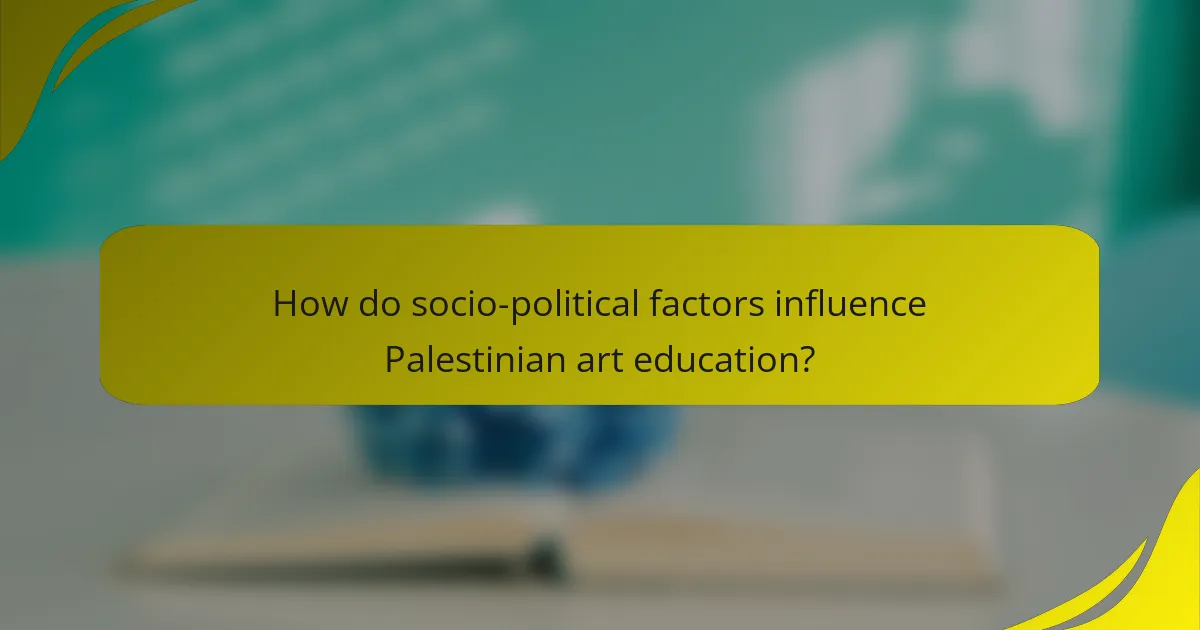
How do socio-political factors influence Palestinian art education?
Socio-political factors significantly influence Palestinian art education. The ongoing conflict and occupation create challenges for access to resources and institutions. Restrictions on movement limit opportunities for artistic collaboration and exposure. Additionally, the political landscape shapes the themes and expressions within Palestinian art. Artists often address identity, resistance, and cultural heritage in their work. Educational institutions may focus on these themes due to their relevance to students’ experiences. Furthermore, funding for art programs can be affected by political decisions. This leads to disparities in the quality of art education available. Overall, socio-political factors play a crucial role in shaping the context and content of art education in Palestine.
What impact do political conflicts have on art education in Palestine?
Political conflicts significantly hinder art education in Palestine. These conflicts lead to restricted access to resources and facilities. Schools often face damage from violence, disrupting educational continuity. Teachers may lack training and support due to unstable conditions. Artistic expression becomes limited as a result of censorship and fear. Students often experience trauma, affecting their creativity and engagement. According to a report by the United Nations, over 50% of schools in conflict areas suffer from inadequate facilities. This environment stifles artistic development and cultural expression.
How do restrictions on movement affect access to art education resources?
Restrictions on movement severely limit access to art education resources. In areas with movement restrictions, students cannot easily reach educational institutions. This results in fewer opportunities for hands-on learning and access to diverse artistic materials. Art educators may struggle to deliver programs due to logistical challenges. Additionally, galleries and workshops become less accessible for students. Research indicates that movement barriers hinder cultural exchange and collaboration in the arts. This affects the overall development of artistic skills in affected regions. In Palestinian territories, such restrictions have historically impacted art education practices and outcomes.
What role do art educators play in advocating for political awareness through art?
Art educators play a crucial role in advocating for political awareness through art. They facilitate discussions about social issues and encourage critical thinking among students. By integrating political themes into art curricula, they help students express their views creatively. Art educators also create platforms for students to showcase their work related to political topics. This empowers young artists to engage with their communities. Research indicates that art can be a powerful tool for social change. Programs in places like Palestine have shown how art education can foster political consciousness. Through workshops and exhibitions, art educators amplify marginalized voices, promoting awareness and dialogue.
How does community engagement shape art education practices?
Community engagement significantly shapes art education practices by fostering collaboration between artists and learners. This collaboration enhances the relevance of art education to local cultural contexts. Engaged communities contribute insights that inform curriculum development. For example, incorporating local traditions and narratives enriches artistic expression. Research indicates that programs involving community input lead to increased student motivation and participation. A study by the National Art Education Association found that community-based projects improve students’ critical thinking skills. Furthermore, community engagement helps build a supportive environment for sharing diverse artistic perspectives. This ultimately leads to a more inclusive and holistic approach to art education.
What are the benefits of community-based art education programs in Palestine?
Community-based art education programs in Palestine enhance cultural identity and promote social cohesion. They provide a platform for self-expression among participants. These programs foster creativity and critical thinking skills. They also encourage collaboration among diverse community members. Additionally, they help preserve and promote Palestinian heritage through artistic practices. Studies show that participants report increased confidence and a sense of belonging. Such programs often address social issues, raising awareness through art. Overall, they contribute to community resilience and empowerment in a challenging socio-political context.
How do local artists contribute to art education initiatives?
Local artists contribute to art education initiatives by providing hands-on workshops and mentorship programs. These artists share their skills and techniques directly with students. They often collaborate with schools and community centers to create engaging art curricula. This involvement fosters a deeper appreciation for the arts among young learners. Additionally, local artists often participate in exhibitions that highlight student work. Such events promote visibility and encourage students to pursue their artistic interests. Research indicates that artist-led initiatives significantly enhance creativity and critical thinking in students. Therefore, local artists play a crucial role in enriching art education.
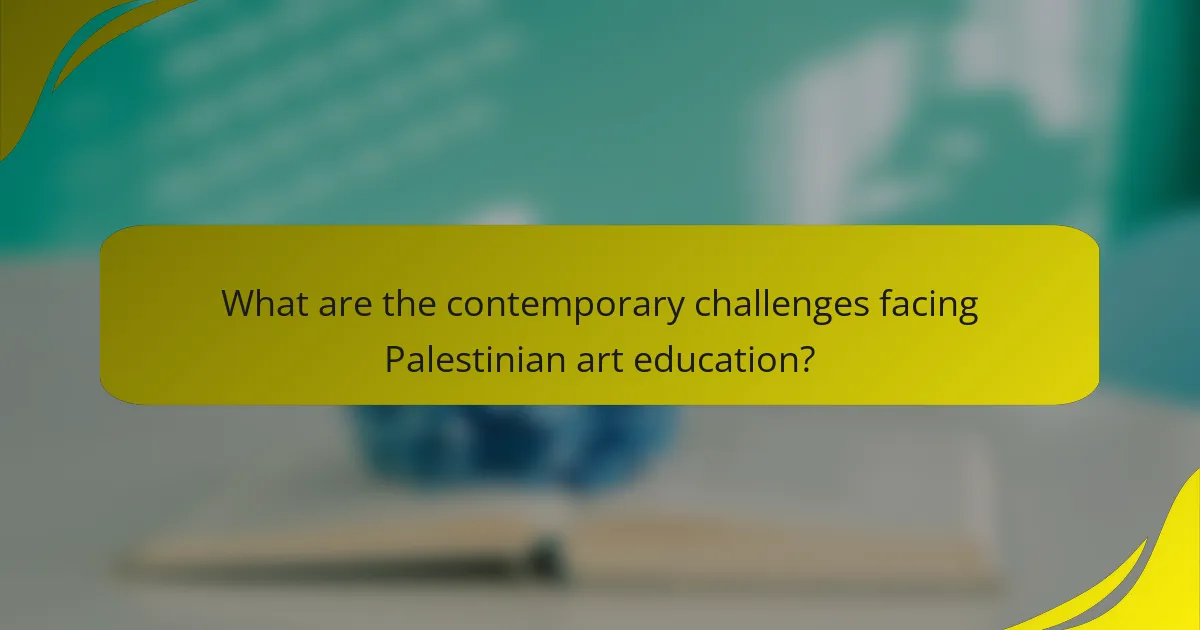
What are the contemporary challenges facing Palestinian art education?
Contemporary challenges facing Palestinian art education include political instability and limited resources. The ongoing conflict affects access to educational institutions. Many art programs struggle with inadequate funding and facilities. Restrictions on movement hinder collaboration and exposure to broader artistic influences. Additionally, cultural censorship impacts the freedom of expression in art. The lack of trained educators further complicates the situation. These factors contribute to a diminished quality of art education in Palestine.
What are the main obstacles to effective art education in Palestine today?
The main obstacles to effective art education in Palestine today include limited resources, political instability, and cultural restrictions. Limited funding affects the availability of materials and trained educators. Political instability disrupts educational programs and access to institutions. Cultural restrictions may inhibit creative expression and curriculum development. According to a report by the Palestinian Ministry of Education, 60% of schools lack adequate art supplies. Additionally, ongoing conflict often leads to school closures, further hindering art education. These factors collectively impede the growth and effectiveness of art education in the region.
How does funding affect the quality of art education in Palestinian schools?
Funding significantly impacts the quality of art education in Palestinian schools. Limited financial resources lead to inadequate materials and facilities for art programs. Many schools struggle to provide basic art supplies, which affects student creativity and learning outcomes. Additionally, insufficient funding restricts access to qualified art educators. This results in a lack of professional development opportunities for teachers. Consequently, students receive a subpar art education experience. Research indicates that schools with better funding can offer more diverse art curricula and extracurricular activities. This enhances student engagement and skill development in the arts. Overall, funding is crucial for improving the quality of art education in Palestinian schools.
What are the challenges faced by art educators in the current political climate?
Art educators face significant challenges in the current political climate. These challenges include limited funding for art programs. Political instability often leads to disrupted educational environments. Censorship can restrict artistic expression and curriculum choices. Additionally, educators may encounter resistance from political entities regarding the relevance of art education. The impact of conflict can diminish access to resources and materials. Furthermore, societal tensions may affect student engagement and participation in art classes. These factors collectively hinder the ability of art educators to effectively teach and inspire students.
What innovative practices are emerging in Palestinian art education?
Innovative practices emerging in Palestinian art education include community-based art initiatives and digital art integration. Community art projects foster collaboration among artists, students, and local communities. These projects often address social issues and cultural identity. Digital art integration utilizes technology to enhance creativity and accessibility in art education.
Workshops and online platforms are increasingly used to teach various art forms. These methods allow for broader participation and engagement. Collaborations with international artists also enrich the educational experience. They bring diverse perspectives and techniques to Palestinian students.
Furthermore, art education is increasingly focused on critical thinking and self-expression. This shift encourages students to explore their identities and narratives through art. Evidence of these practices can be seen in institutions like the International Academy of Art Palestine, which promotes innovative curricula.
How are digital tools being used to enhance art education in Palestine?
Digital tools are enhancing art education in Palestine by providing access to online resources and platforms. These tools facilitate virtual art classes and workshops, allowing students to learn from remote instructors. Digital software enables the creation and sharing of artwork in various formats. Online galleries showcase Palestinian artists, promoting cultural exchange and visibility. Social media platforms connect students with global art communities. Additionally, digital tools support collaborative projects, fostering teamwork among students. This integration of technology enriches the learning experience and expands educational opportunities in the region.
What role does international collaboration play in advancing art education?
International collaboration plays a significant role in advancing art education by enhancing the exchange of ideas and resources. Collaborative projects between institutions can provide access to diverse artistic techniques and methodologies. This exchange fosters innovation and creativity among students and educators. For instance, joint exhibitions and workshops can introduce new perspectives and practices. Additionally, international partnerships can lead to funding opportunities for art programs. Research indicates that such collaborations improve educational outcomes and broaden cultural understanding. Programs like the European Union’s Creative Europe have supported transnational projects that enrich art education. Overall, international collaboration strengthens the quality and scope of art education.
What best practices can enhance Palestinian art education?
Integrating community engagement can enhance Palestinian art education. This approach fosters collaboration between artists, educators, and students. Workshops led by local artists can inspire creativity and cultural expression. Incorporating traditional art forms into the curriculum preserves cultural heritage. Access to diverse art materials supports varied artistic practices. Establishing partnerships with cultural institutions can provide resources and exhibition opportunities. Utilizing technology in art education can broaden learning experiences. Encouraging critical discussions about art can develop analytical skills. These practices collectively strengthen the educational framework for Palestinian art.
How can art educators foster resilience and creativity among students?
Art educators can foster resilience and creativity among students by creating a supportive learning environment. This environment encourages experimentation and values the process of creation over the final product. Educators should incorporate diverse artistic techniques and cultural perspectives in their curriculum. This approach helps students express their identities and experiences through art.
Additionally, providing opportunities for collaborative projects enhances teamwork and communication skills. Research shows that collaboration in art education promotes critical thinking and problem-solving abilities. Encouraging reflection on personal and collective experiences can deepen emotional understanding and resilience.
Art educators can also introduce challenges that require innovative solutions. These challenges can stimulate creative thinking and adaptability. By celebrating failures as learning opportunities, educators can instill a growth mindset in students. This mindset is essential for building resilience and fostering creativity.
What strategies can be implemented to improve access to art education resources?
Implementing community partnerships can significantly improve access to art education resources. Collaborations between schools, local artists, and cultural institutions can enhance resource availability. Establishing after-school programs can provide additional art education opportunities. Utilizing digital platforms can expand reach to remote areas, offering online classes and resources. Funding initiatives can support scholarships for underprivileged students to access art education. Creating mobile art education units can bring resources directly to underserved communities. Research indicates that such strategies lead to increased participation in art programs, fostering creativity and cultural expression.
The main entity of this article is Palestinian art education practices. The article examines the historical influences that have shaped these practices, including the impact of the Ottoman Empire, the British Mandate, and the 1948 Nakba. It explores how cultural factors, colonial history, and socio-political conditions have affected the curriculum and accessibility of art education in Palestine. Additionally, it highlights contemporary challenges and innovative practices within the field, emphasizing the role of community engagement and international collaboration in enhancing art education. Overall, the article provides a comprehensive overview of the complex interplay between historical events and cultural identity in Palestinian art education.
